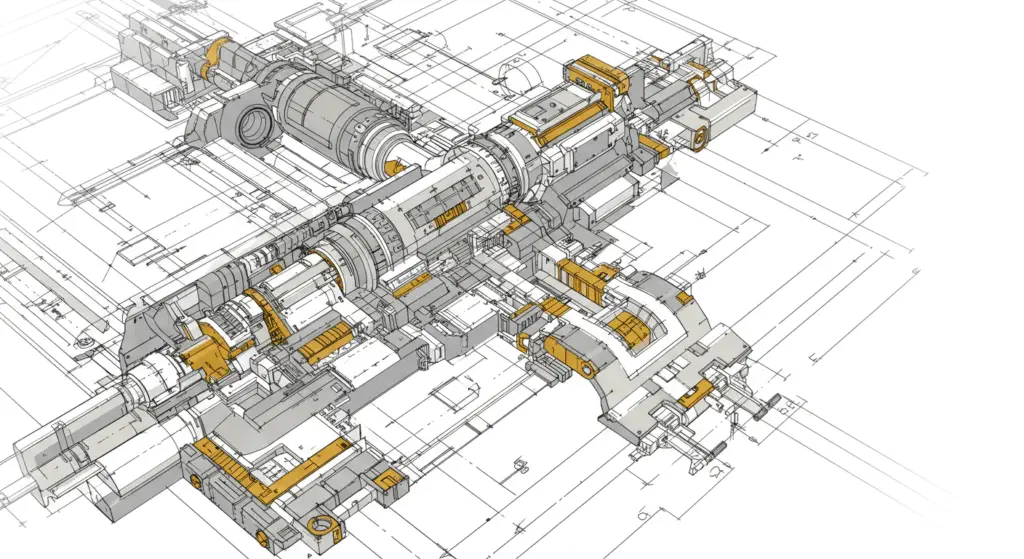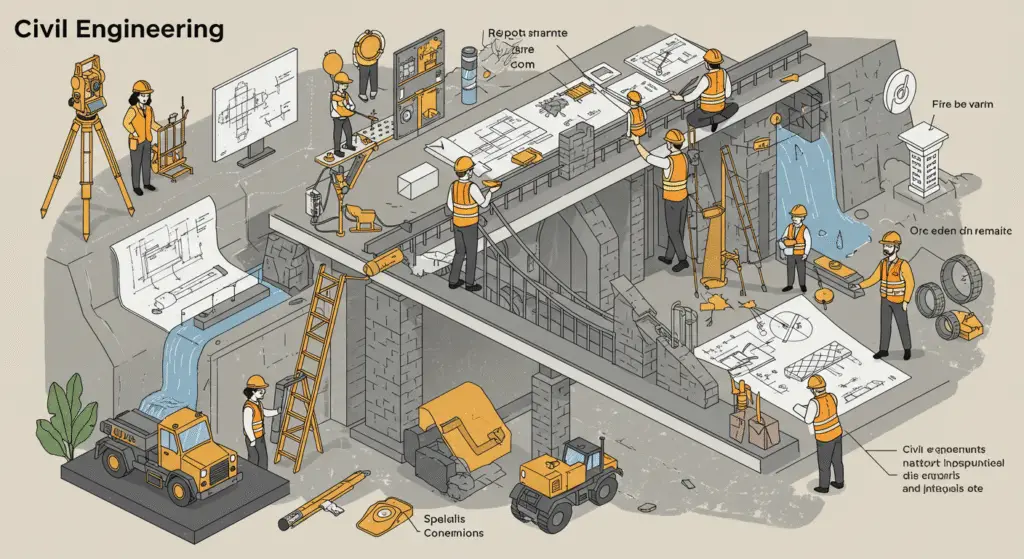What is it in civil engineering?

civil engineering
In the ever-evolving landscape of human civilization, few disciplines have had a more profound and lasting impact than civil engineering. As the cornerstone of the built environment, civil engineers are tasked with the design, construction, and maintenance of the infrastructure that supports our daily lives, from the roads and bridges we traverse to the buildings and utilities that provide shelter, power, and water.
At its core, civil engineering is the application of scientific and mathematical principles to the development and management of the physical systems and structures that underpin modern society. However, the scope and responsibilities of civil engineers extend far beyond these practical considerations, encompassing a diverse array of specializations and an unwavering commitment to the betterment of the human condition.
In this comprehensive article, we will delve into the multifaceted realm of civil engineering, exploring its core components, the key areas of specialization, and the critical role these professionals play in shaping the world around us.
The Foundations of Civil Engineering

Civil engineering is a broad and multidisciplinary field that draws upon the principles of various scientific and technological disciplines, including physics, mathematics, materials science, and environmental science. At its core, the practice of civil engineering is focused on the design, construction, and maintenance of the built environment, ensuring that the physical infrastructure that supports our communities is safe, functional, and responsive to the evolving needs of society.
The foundational domains of civil engineering include:
Structural Engineering: Responsible for the design and analysis of buildings, bridges, dams, and other large-scale structures, ensuring they can withstand the stresses and loads placed upon them.
Transportation Engineering: Focused on the planning, design, and operation of transportation systems, including roads, highways, railways, airports, and public transit.
Environmental Engineering: Concerned with the development and implementation of sustainable solutions for water supply, wastewater treatment, and the management of air, water, and land resources.
Geotechnical Engineering: Specializing in the analysis and design of foundations, earthworks, and other geological and soil-related aspects of infrastructure projects.
Construction Engineering: Involved in the planning, scheduling, and management of construction projects, ensuring they are completed efficiently, safely, and within budget.
Water Resources Engineering: Responsible for the design and management of water supply and distribution systems, flood control measures, and irrigation infrastructure.
These diverse fields within civil engineering are highly interconnected, and civil engineers often work collaboratively to address the complex challenges faced in the built environment.
Shaping the Built Environment

One of the primary responsibilities of civil engineers is to design and construct the physical infrastructure that supports our communities and enables economic and social development. From the planning and construction of transportation networks to the design of buildings, water systems, and energy infrastructure, civil engineers play a pivotal role in shaping the built environment.
Transportation Infrastructure
Civil engineers are at the forefront of designing and constructing the transportation systems that facilitate the movement of people, goods, and services. This includes the planning and design of roads, highways, bridges, railways, airports, and public transit systems, all of which are crucial for supporting economic growth, connecting communities, and ensuring the efficient flow of traffic.
By applying their expertise in structural analysis, geotechnical engineering, and transportation planning, civil engineers develop innovative solutions to address challenges such as traffic congestion, safety concerns, and the need for sustainable mobility options.
Building and Utility Infrastructure
In addition to transportation infrastructure, civil engineers are also responsible for the design, construction, and maintenance of the buildings and utility systems that provide shelter, power, water, and other essential services to communities. This includes the design of residential, commercial, and public facilities, as well as the development and management of water supply and distribution systems, wastewater treatment plants, and energy distribution networks.
By integrating principles of environmental engineering, structural analysis, and systems design, civil engineers ensure that these vital systems are efficient, resilient, and capable of meeting the evolving needs of communities.
Sustainable and Resilient Infrastructure
As the world grapples with the challenges of climate change, resource scarcity, and population growth, the role of civil engineers in developing sustainable and resilient infrastructure has become increasingly crucial. Civil engineers are at the forefront of designing and implementing solutions that minimize the environmental impact of infrastructure projects, promote the use of renewable resources, and enhance the ability of communities to withstand and recover from natural disasters and other disruptions.
This includes the development of green buildings that prioritize energy efficiency, water conservation, and the use of sustainable materials, as well as the design of transportation systems that encourage the use of public transit, walking, and cycling. Civil engineers are also instrumental in the development of flood control measures, water management systems, and disaster-resilient structures that can help communities adapt to the changing climate and mitigate the impacts of extreme weather events.
By embracing the principles of sustainability and resilience, civil engineers are shaping a future where the built environment is not only functional and efficient but also environmentally responsible and capable of withstanding the challenges of the 21st century.
Improving Quality of Life
Beyond the physical infrastructure they design and construct, civil engineers also play a vital role in enhancing the overall quality of life for individuals and communities. Their work directly impacts aspects such as public health, environmental protection, and social equity, making them key contributors to the well-being and prosperity of society.
Public Health and Safety
The infrastructure designed and maintained by civil engineers has a direct impact on public health and safety. From the provision of clean water and proper sanitation to the design of safe transportation systems and disaster-resilient structures, civil engineers ensure that the built environment supports the physical and mental well-being of the people who live, work, and play within it.
Environmental Stewardship
Civil engineers are also at the forefront of environmental protection and conservation efforts, working to mitigate the impact of infrastructure development on natural ecosystems. By incorporating sustainable practices, promoting the use of renewable resources, and implementing strategies to minimize pollution and resource depletion, civil engineers contribute to the preservation of the environment and the long-term sustainability of our communities.
Social Equity and Inclusion
The decisions and designs of civil engineers can also have significant implications for social equity and inclusion. Through the strategic planning and development of transportation networks, housing, and public facilities, civil engineers can help ensure that the built environment is accessible, affordable, and responsive to the diverse needs of all members of the community, including underserved and marginalized populations.
By prioritizing these social and environmental considerations, civil engineers can help create communities that are not only physically functional but also inclusive, equitable, and conducive to the overall well-being and quality of life of their residents.
The Future of Civil Engineering
As the world continues to evolve and face new challenges, the role of civil engineering will become increasingly crucial in shaping the future of our built environment. Some of the key trends and developments that will shape the future of civil engineering include:
Technological Advancements: The integration of emerging technologies, such as artificial intelligence, robotics, and digital twins, will enhance the efficiency, precision, and sustainability of civil engineering practices, from design and construction to infrastructure management and maintenance.
Sustainability and Resilience: The growing emphasis on environmental protection, climate change adaptation, and resource conservation will drive civil engineers to develop innovative solutions that prioritize sustainability, circular economy principles, and the resilience of infrastructure systems.
Urbanization and Smart Cities: As the world becomes increasingly urbanized, civil engineers will play a central role in the planning and development of smart cities, leveraging data-driven approaches and integrated infrastructure systems to create more livable, efficient, and sustainable urban environments.
Interdisciplinary Collaboration: Civil engineering will continue to evolve as an increasingly collaborative discipline, with civil engineers working alongside experts from fields such as urban planning, public policy, environmental science, and social sciences to address the complex, multifaceted challenges facing our communities.
By embracing these emerging trends and adapting their problem-solving approaches accordingly, civil engineers can position themselves as driving forces in addressing the grand challenges of our time and shaping a more sustainable, resilient, and prosperous future for all.
Conclusion
At the heart of the built environment, civil engineering stands as a vital and dynamic profession, responsible for shaping the physical infrastructure that supports the progress and well-being of our societies. From the design and construction of transportation networks to the development of sustainable and resilient buildings and utilities, civil engineers play a pivotal role in addressing the complex challenges facing the world today.
As the global landscape continues to evolve, the expertise and innovative spirit of civil engineers will be essential in driving progress, enhancing public health and safety, promoting environmental stewardship, and improving the overall quality of life for individuals and communities. By leveraging the latest technological advancements, embracing principles of sustainability and resilience, and fostering interdisciplinary collaboration, civil engineers can contribute to the creation of a more sustainable, equitable, and prosperous future for all.
The future of civil engineering is filled with both challenges and tremendous opportunities. By rising to the occasion and continuing to push the boundaries of what is possible, civil engineers can ensure that the built environment they create serves as a testament to their dedication, creativity, and unwavering commitment to improving the human condition and shaping a better tomorrow.

- https://worldcivilsociety.com/civil-engineering-landscape-exploring-salaries-and-career-prospects-in-kenya
- https://worldcivilsociety.com/the-vital-role-of-civil-engineering-in-shaping-our-built-environment/
- https://worldcivilsociety.com/different-types-of-engineering/
- https://worldcivilsociety.com/mastering-the-art-of-problem-solving-exploring-the-five-essential-methods/
Pingback: Mastering the Engineering Design Process: A Systematic Approach to Problem-Solving – worldcivilsociety.com
Pingback: Navigating the Engineering Design Process: A Comprehensive Guide to Innovative Problem-Solving – worldcivilsociety.com
Pingback: engineering